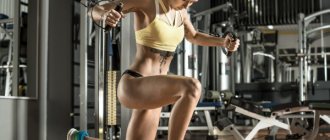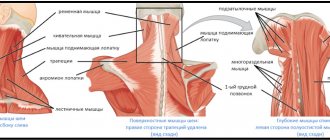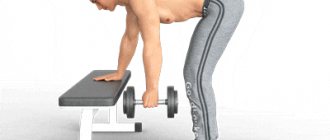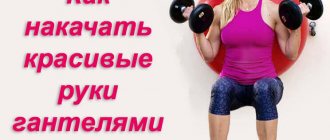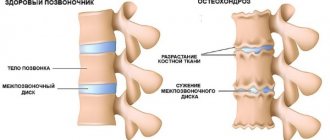A developed back is needed not only by bodybuilders and athletes who strive to build a proportional body. This muscle group is important in strength sports. A muscle corset protects the spine from injury and helps keep it healthy. The back is involved in many exercises, which indicates the need to pay special attention to the training process, for example, with dumbbells, taking into account safety precautions, goals, body characteristics, and so on.
- Back muscle anatomy, muscle strengthening
- Contraindications to exercises with dumbbells
- Basic exercises for the back and lower back with dumbbells
- The best back workout with dumbbells at home
- Deadlift
- Deadlift on straight legs
- Bent leg deadlift
- Bent-over dumbbell row
- Raising dumbbells to the back to the waist
- Bent-over dumbbell raises
- Lateral bends
- Lifting dumbbells to the chin
- General recommendations for performing back exercises with dumbbells
Back muscle anatomy, muscle strengthening
The back muscles are involved in most exercises (with the exception of some isolated movements). This is due to the structural features of the human body in general and the muscle corset in particular.
All back muscles can be divided into several groups:
- latissimus dorsi
- trapezius muscles
- semispinalis capitis muscles.
- splenius capitis muscles
- levator scapula muscle
- serratus posterior superior muscles
- rhomboid major muscles
- erector spinae muscles
- serratus posterior inferior muscles
Back muscles
Back muscle groups
Back muscle groups
Many exercises that are used in the training process immediately develop most of the back muscles. For example, deadlifts (including dumbbells), belt rows, pull-ups, and so on are used as the main load. More experienced athletes supplement their classes with more isolated exercises that are aimed at certain muscles individually. It will be impossible to completely isolate a separate back muscle and pump only one of it due to anatomical features.
Conventionally, athletes divide the back muscles into top, middle and bottom. This or that movement is aimed at developing a certain part, for example, hyperextensions or bending help in developing the lower part (lumbar region), and pull-ups on the bar help the upper part.
How to train your back
Now it has become clear to us that on the back of the back there is not one, but a large array consisting of different muscles. Therefore, you should not waste time searching for a single exercise in order to use it to perform isolated movements. Yes, such exercises simply do not exist, especially when it comes to training at the beginning of a sports career. Later, when all the capabilities of dumbbells are completely exhausted, in order to continue improving your body, you will need exercise machines and other gymnastic equipment.
All professionals unanimously say that there is only one exercise for pumping up wings. The essence of its implementation is as follows. First, you need to acquire at least one eight-kilogram dumbbell. This weight is the minimum for beginners. If you take more weight, then other muscles will take part in the movement, which is not what we need.
Too little weight is also not exactly what we need. The load on the muscles will be small and in order to achieve something, you will have to repeat the same movements over and over again. The result of such an exercise is close to zero, although the exercise technique can be worked out at first.
And one more item, without which it will be impossible to perform the exercise. This is a gymnastic bench or any stable support, the height of which will be at knee level.
Now let's look at how the exercise is performed:
- Go to the bench and take a dumbbell in your right hand. The grip does not play a special role, but it is advised to still take the projectile so that the palm is directed towards the thigh. This is a natural position, and this is where you will need to start doing the exercise.
- Lean your body forward. It should be parallel to the floor. Pay attention to the position of your legs, this is very important. In general, the starting position should be taken with the legs apart. First, take about a quarter step back with your right foot. And the left leg should take a position at the same distance, but only in front. Now you can bend at the waist.
- With your left hand, lean on a bench or other support you have. The right hand with the dumbbell should hang freely. This position should be comfortable for you, because you will have to perform a rather complex and difficult exercise. Therefore, find an acceptable position for your legs yourself. The main thing we pay attention to again is that the right leg should be slightly behind, and the left leg in front.
- Alternatively, you can try placing your left thigh on a bench or whatever replaces it. This will give the body a more stable position and you will not have to constantly be distracted by maintaining balance. So try to take the starting position according to the first or second option and, whichever you like best, use in the future.
- Now a few words about the exercise itself. Its technique consists of the following movements. Pay attention to the body. During training movements, it should remain in the same position all the time. It is very difficult to follow this yourself, so, at least at first, ask someone you know to do it.
- The second important point is that the hand should move only along an imaginary vertical line: up and down.
- Lower your shoulder a little. Take a deep breath and hold your breath. Using tense back and deltoid muscles, lift the dumbbell as high as possible. At the moment when the projectile is at the minimum distance from the shoulder, connect the shoulder itself. Due to this, the movement should continue a little longer. At this moment, the upper part of the wings and the muscles of the middle back will receive maximum load, and the listed muscles will contract to their minimum.
- As soon as this happens, stop moving your hand for a few seconds. It is at this moment that the greatest changes occur in the muscle tissue of the wings of the back.
- Now you can exhale and slowly lower your hand.
After you have completed the planned number of movements, change your body position to continue this exercise, but this time with your left hand.
Contraindications to exercises with dumbbells
Most often, exercises with a barbell are used in the training process. They are easier to learn, and the technique for performing them will be accessible even to beginners. In some cases (in the absence of a barbell during home training, the desire to diversify the process, and so on), dumbbells are used.
The use of dumbbells has a number of contraindications:
- If you have a number of diseases, it is not recommended to put too much strain on your spine. This can only lead to aggravation of the situation.
- The presence of injuries is also a reason to hold off on additional exercise.
- Using dumbbells may be more challenging for beginners. They are not always able to correctly distribute the load or select the right weight. In some cases, it is better to get by with a barbell with a light weight.
- The barbell allows you to perform more basic exercises. Movements with dumbbells are more isolated.
Back pain is a signal of possible problems
If you have back problems, it is recommended to consult a specialist
If you have back problems, it is recommended to consult a specialist
It is worth paying special attention to the presence of other contraindications. Training for high blood pressure should be agreed with a doctor and strictly under the supervision of an experienced trainer. Many pathologies, such as asthma, diseases of the cardiovascular system, hernias and other disorders, can even lead to the exclusion of serious loads, including when working on the back with dumbbells. Sometimes it is better to limit yourself to general strengthening physical education, therapeutic exercises, and so on.
Basic exercises for the back and lower back with dumbbells
When drawing up a training program, you should proceed from the goals that the athlete sets for himself. This could be increasing body weight, losing weight, strengthening back muscles, developing strength, or a combination of tasks.
Training with dumbbells usually involves performing the following exercises:
- Deadlift with dumbbells (there are several options)
- Bent-over dumbbell row
- Lifting to the back to the waist
- Bent-over dumbbell raises
- Lateral tilts
- Lifting dumbbells to the chin
If it is not possible to use a barbell, then these movements should be taken as a basis. It is recommended to combine exercises, including both basic ones (deadlift with dumbbells) and more isolated ones in one training day.
Back workout example:
- Deadlift with dumbbells on straight legs. 3 sets of 10 reps.
- Bent-over dumbbell raises. 4 sets of 12 reps.
- Lift to the chin. 4 sets of 12–15 reps.
If possible, pull-ups and hyperextensions are also included.
The number of sets and repetitions will vary significantly depending on the goals, as well as the athlete's training level. Thus, beginners use light weights, but perform up to twenty repetitions, even if their goal is to build muscle mass. The bottom line is that at the initial stage it is necessary to prepare the muscles, as well as strengthen the joints, ligaments and spine for subsequent loads. More experienced athletes can perform a small number of repetitions with a large weight (when working “for strength”), as well as from 20 or more repetitions to 6 approaches (during “drying”).
The best back workout with dumbbells at home
Deadlift
The deadlift is one of the main exercises used to develop the back. However, it is quite traumatic, which makes compliance with safety precautions when performing it especially important. Since the exercise is basic, it is better to include it at the beginning of your workout. It is recommended to perform 3-4 working approaches, but everything will depend on the task and the athlete’s level of training. The number of repetitions at the initial stage is from 10. Later, it is allowed to perform the exercise for a smaller number with a larger weight, when the technique is fully mastered.
There are several options for deadlifts, let's look at two of them.
Deadlift on straight legs
The exercise trains the upper hamstrings, gluteal muscles, and spinal extensor muscles.
- Legs are slightly narrower than shoulders. The back is straight, in each hand there is a dumbbell of the same weight.
- Bend your lower back slightly so that your pelvis moves slightly back when tilted.
- Move your body forward slightly, holding the dumbbells in front of you.
- Inhale and, holding your breath, bend forward until your body is parallel to the floor or until your back remains straight.
- The center of gravity shifts forward, the legs do not bend. The pelvis goes back a little.
- Start the ascent and exhale as you pass the heaviest part.
Deadlift on straight legs
Body position when performing deadlifts
To ensure maximum contraction of the buttocks and hamstrings, keep your legs straight and locked at the knees.
Bent leg deadlift
It is important to perform the exercise smoothly, avoiding jerking.
- The legs are slightly narrower than the shoulders, the knees are bent. In each hand there is a dumbbell, the backs of the palms facing outward.
- Inhale and bend until your back is parallel to the floor, or until your lower back begins to round; dumbbells slide along your legs.
- As you exhale, the body returns to its original position.
Bent leg deadlift
Body position when performing bent leg rows
When performing the exercise, you must monitor the position of your back and prevent it from bending. Poor technique can lead to muscle strain or more serious injury.
Bent-over dumbbell row
This exercise is similar to the bent-over barbell row. It also involves several muscles at once, so it can be considered basic. As a rule, 3–4 approaches are performed, and the number of repetitions depends on the athlete’s goals (from 8 to 20 or more).
- Feet shoulder-width apart or slightly narrower.
- Take a dumbbell in each hand.
- We tilt the body forward. The angle between the back and the floor is slightly more than 90 degrees.
- As you exhale, pull the dumbbells towards your stomach, trying to bring your shoulder blades together.
- As you inhale, return your arms to the starting position.
Bent over row
Exercise technique
A slight asymmetry in muscle development is normal, so movements with one arm may be somewhat easier than the other. In any case, it is worth performing an equal number of repetitions with each hand. During movement, you need to pay special attention to which muscle is being loaded. The work should involve the back muscles as much as possible, in particular the upper and middle muscles, but not the arms or shoulders. Shifting the load indicates incorrect technique for performing the exercise.
Raising dumbbells to the back to the waist
The exercise mainly works the middle of the back, but also uses other muscle groups. It replaces the thrust of the lower block.
- Prepare a bench or bench. A bench press or other object of similar size will be suitable.
- One knee is placed on the bench, while the back should be parallel to the surface of the bench.
- If the left foot is on the bench, then the emphasis is also made with the left hand. The dumbbell is held with the opposite hand.
- The dumbbell is pulled to the stomach, then to the starting position.
- After completing the required number of repetitions, the exercise is performed with the second hand.
- As you exhale, you need to raise the dumbbell, and as you inhale, lower it.
Bent-over dumbbell row
Body position when performing the exercise
An important point is the correct technique for performing the exercise. The work should involve, first of all, the muscles of the back, not the arms. You need to ensure that the load is placed on the back, and not on the arms or other muscle groups. It is recommended to perform 3-4 sets of 8-20 repetitions, depending on what the athlete's goal is.
Bent-over dumbbell raises
The exercise is focused on developing the upper back. It is necessary to be guided by the following points:
- Take a dumbbell in each hand. It is better to use light weight at first.
- The knees bend slightly, but the lower back should not bend.
- The body leans down, the back should be almost parallel to the floor.
- As we inhale, we spread our arms to the sides. We hold our breath at the highest point.
- Then the projectiles are lowered as you exhale.
Bent-over dumbbell raises
Exercise technique
The exercise is considered effective, but is recommended as an auxiliary exercise. The main emphasis should be on basic ones, such as deadlifts or belt rows. The required number of approaches and repetitions are performed. The exercise is not a basic one, so it is used as an additional exercise. As a rule, 3-4 sets, 12 to 20 repetitions each, are enough.
Lateral bends
Lateral bending develops the abdominal muscles to a greater extent, as well as the oblique abdominal muscles. However, to some extent they also load the back, in particular the lower back. When performing, you need to be guided by the following points:
- Feet are placed shoulder width apart. The back should be straight.
- Take a dumbbell in each hand, but you can use one at a time.
- A side tilt is made, then the body returns to its original position. Do not bend forward or backward; keep your lower abdomen tucked in to avoid excessive arching in the lower back.
- The dumbbells should move along the body in the same plane.
- It is necessary to ensure that the load is on the back and abdominal muscles, and not on the arms.
- When you bend to the side, you inhale, and when you lift the dumbbell, you exhale.
Side bends with dumbbells
Exercise technique
Bends can be performed on each side alternately, using one dumbbell, or you can use two at once and perform alternate movements
Lifting dumbbells to the chin
The exercise is aimed at developing the upper back as well as the shoulders. It is recommended to perform it at the end of a back workout, with light weight. The number of repetitions is from 10 or more, depending on the program and goals.
- The legs are slightly narrower than the shoulders. The back is straight.
- In each hand there is a dumbbell. You should hold them in front of you with your palms facing outward.
- As you exhale, pull the dumbbells to your chin, elbows pointing to the sides.
- As you inhale, lower the dumbbells along your body.
Lifting dumbbells to the chin
Exercise technique
The main load should fall on the upper back and shoulders. If your arms get tired first, this indicates an incorrect technique for performing the exercise. The exercise puts a significant load on the shoulders, this point must be taken into account when drawing up a training program. There is no point in performing it in a low-repetition mode, so 12 or more is recommended.
How to pump up your back with dumbbells at home: effective training
Do you want to pump up your back at home? Are you looking for an effective set of exercises to pump up your back muscles? This article describes a workout for the trapezius, latissimus and longus dorsi muscles using dumbbells, developed by a fitness trainer. A detailed description of each training element is accompanied by video instructions. Follow the correct technique for completing tasks. Avoid sudden movements that can lead to micro injuries. Before starting the complex, take 5-10 minutes to warm up.
Read: A set of exercises for warming up
A set of exercises for the back with dumbbells for men
| Exercises | Sets | Repetitions/Time |
| Bent-over dumbbell rows towards the waist | 3 | 12,10,8 |
| Deadlift with dumbbells on straight legs | 3 | 15 |
| Bent-over dumbbell raises | 3 | 12-15 |
| One-arm dumbbell row with emphasis on the knee | 3 | 12,10,8 |
| Dumbbell sumo deadlift | 3 | 15,12,10 |
General recommendations for performing back exercises with dumbbells
When performing back exercises with dumbbells, you need to consider some recommendations:
- You need to start your workout with a warm-up. Particular attention should be paid to the lower back.
- If you have back injuries, sprains, spinal diseases, as well as certain diseases (heart disease, asthma, etc.), significant physical activity should be avoided.
- You need to start training with light weights. It is recommended to increase the load gradually.
- For some exercises, it is recommended to use an athletic belt, especially if there are problems with the spine.
- The technique of performing the exercise is of primary importance.
- If possible, consult a doctor before starting classes, and conduct training with a trainer.
- Watch your breathing: important.
The main recommendation is compliance with the technique, as well as other precautionary rules and the principle of gradual progression.
Back exercises with dumbbells will allow you to develop this muscle group properly. Dumbbells can sufficiently replace a barbell and will also help diversify the training process. When performing movements, it is necessary to follow the technique and be guided by the recommendations outlined, since otherwise the effectiveness will be questionable, and the negative consequences can be significant.
